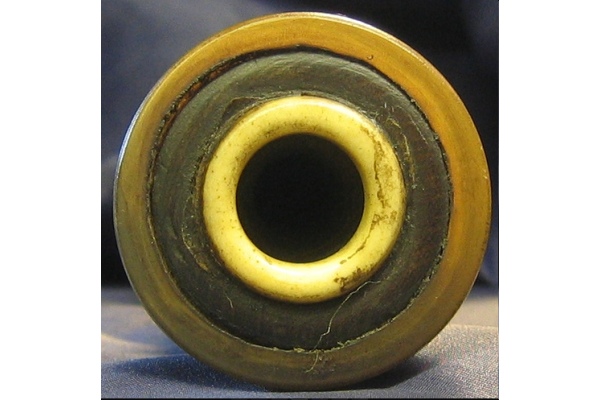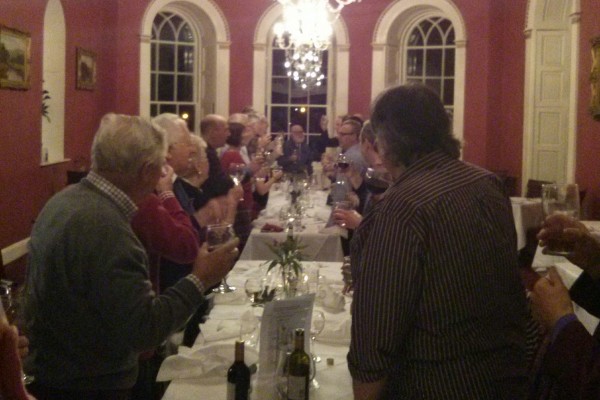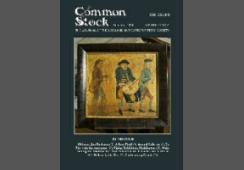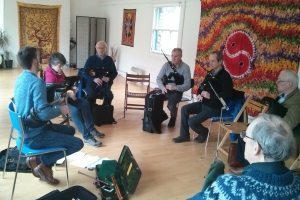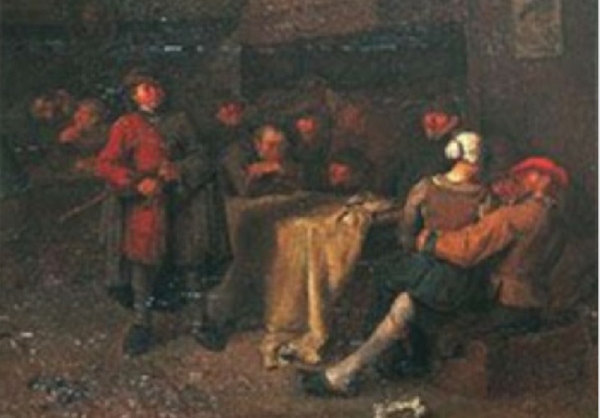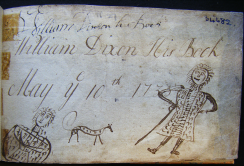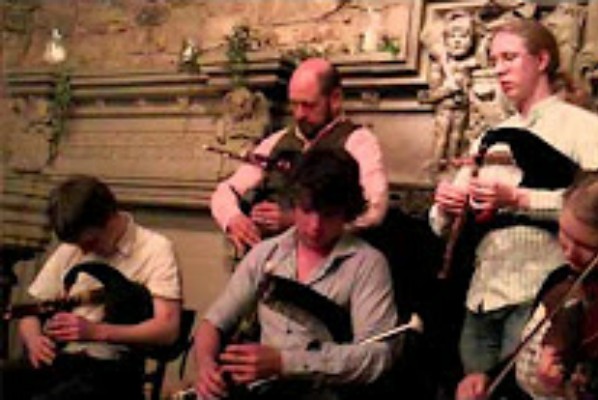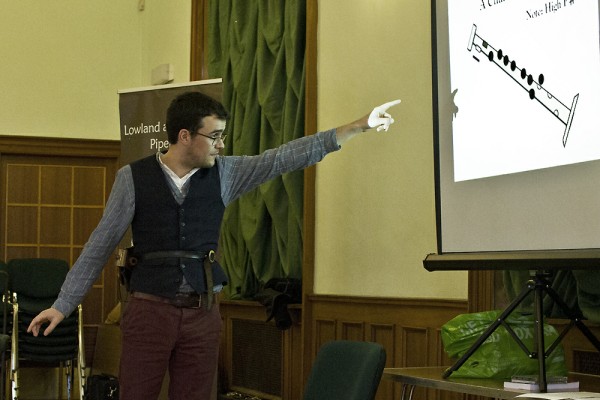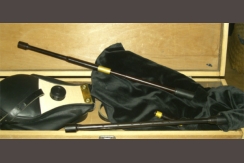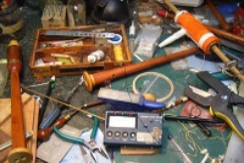Early Scottish Pipers and their music 1400 - 1700
An edited version of a paper given at the 2015 Musica Scotica conference in Glasgow, April 26th. Along with some new material, it gathers together in one place text music and images that have previously appeared in various publications
The story of piping in Scotland, at least as it is told in documentation, beings in 1362, when David II gave 40 shillings to ‘piparijs’, although we cannot be sure that these were ‘bag-pipers’ – the word was generally used to describe any number of musical instruments of a ‘pipe-like’ nature.
Fifteen years later in the Earldom of Morton in Dumfriesshire, a piper of some sort held a 4 shilling land at ‘Piperstede’, suggesting patronage of the kind that both individuals and Burgh Councils would later provide for their bagpipers.
No further payment to pypars appears in the royal accounts for the next hundred years.
My purpose, however, is not to attempt a full survey of the history of Scottish piping; what I want to do is to introduce such imagery as survives from the early material record, and to relate this to the music that contemporary texts tell us these pipers played.

I’ve chosen to start with this carving because it is contemporary with the first appearance in the records of one of the best-documented pipers in the Scottish Lowlands.
In 1603, a piper named Robert Simpson was banished from Paisley for various misdemeanours. It seems most likely that he then moved westward to become piper to the residents of the small town of Kilbarchan.
His life there was celebrated in an elegy ‘The Life and Death of the Piper of Kilbarchan’ and though he is said to have died around 1620, two of the tunes we are told he played, ‘The Day it Daws’ and ‘Hunt’s Up’, take us back to the beginning of the 15th century and the earliest representations of bagpipers in Scotland.
Scotland’s first named bagpiper
Scotland’s first named bagpiper
Before we take a tour of these images, I want to introduce our first named Scottish bagpiper, Clarus the lang clype; he appears in an extraordinary narrative poem from the late 15th century, known as Colkelbie’s Sow:
“And Clarus the lang clype playit on a bag pype”
Not only is Clarus our first named piper but this is probably the first appearance in Scottish literature of the word bagpipe.
I’m not going to try to summarise the story of this poem, but at one point Clarus and another minstrall, named Dicky doyt, who plays a pipe ‘made of borit bourtre’ – that is, bored elder – are called upon to play various tunes while the company dances a long list of dances from across Europe:
“Sum trottit tras and trenass
Sum balterit the bass…
Sum ourfute Sum orliance
Sum rusty bully with a bek”
Many of these tunes can be traced to some extent, but one of the most obvious is ‘Rusty Bully’, a dance tune known throughout Europe in the 15th century. It appears in basse dance settings in several 15th century manuscripts such as the Brussels Man- uscript, and another from Italy published in 1450. The title, incidentally, means Roasted and Boiled, and the English poet John Skelton mentions it in a poem from around 1495: ‘He lumbryth on a lewd lute Rotty Bully Joye’.

The setting here is an attempt, based on the ‘piva’ section of the manuscript music, to realise this tune as Clarus the bagpiper might have played it.
To accompany the tune I offer a tour of the images of bagpipes that are known from the 15th century in Scotland. Notice that all these pipers have a similar bagpipe - the single, long drone and short chanter. This type of bagpipe was known across western Europe from the late 13th century onward, and is very like that still played today in Northern Spain and elsewhere.

Skirling Castle
Late 14th - early 15th century ?
Now on the wall of a house in Skirling village near Peebles, it may well have come from Skirling Castle, in which case it may date from the late 14th or early 15th century; the figures 14 and 15 are painted on the wall either side of the piper’s legs.

Haddington St Mary’s,
early 15th centuryA recently re-discovered remnant; the church was consecrated in 1416

Melrose Abbey, early 15th century
The Abbey was destroyed in 1385 and rebuilding began soon after. The piping pig is at the very top of the nave walls, so it probably dates from the first decades of the 15th century.


Rosslyn Chapel - Rosslyn Chapel was built between 1460 and 1480
The Common Pyperis of the Towne
On August 15th, 1487 the following Act of Council was entered in the records of the city of Edinburgh:
‘The quhilk day the provest baillies counsale and deikynis of the towne [ordanis] that the commoun pyperis of the towne be feyit for the honour of the town,’
This record is among the earliest that mark the beginning of the tradition of the ‘Common Pyper’ engaged by the Lowland Burghs to act as reveille and curfew, a tradition that survived in some places into the early years of the 19th century. At this time the city had three pipers. Given the potential ambiguity of the word piper, one or more of these three pipers may well have been a schawm player, as was the case in European towns at the time.
However, in 1507 the James IV gave money to ‘ane piper that playit with the schawmeris’; at least we know that at that time the term ‘pypar’ did not mean a shawm player, and almost certainly meant a bagpiper.
These Edinburgh pipers, however, failed to impress the poet Dunbar, who complained not just of their playing standard but also of their limited repertoire, and in so doing gave us the names of one fo the earliest records of tunes these Town pipers played.
‘Your common minstrel has no tune
But ‘Now the Day Daws’ and ‘Into June’
[Dunbar, c. 1512]
‘Tharto, thir byrdis singis in the schawis
As menstralis playing ‘The joly day now dawis’
[Douglas, c. 1512]
The second tune remains unidentified. The first, however, was to be the standard morning tune not just in Edinburgh and Kilbarchan but probably elsewhere too. The tune that Douglas and Dunbar knew was identified by John Leyden in 1801 as that of the song in the Fairfax manuscript titled, ‘The Gentil Day Dawes’, which was probably written for the marriage of Henry VII to Elizabeth in 1485.
The song is artfully composed using what was probably already a popular song. Here is a section of the score of the song transcribed from the black-note mensuration of the original manuscript (which is in the Bodleian Ashmole manuscripts), followed by my proposed version of the original tune on which this setting was based.


I have been unable to find any representation of a bagpipe from 16th century Scotland. 1549, however, saw the publication of The Complaynt of Scotland whose sixth chapter contains the renowned monologue that includes a list of seven musicians, one of whom plays ‘ane drone bag pipe’, along with a list of dances, songs and stories, all of which have been much discussed. I’m going to concentrate on the one the text calls ‘The Dede Dance’.

Heidleberger Totentanz, 1488

Part of the Dance of Death
at Rosslyn Chapel
The dance of death was known across Europe from the 15th century; the words here are the opening and closing lines of the ballad, as printed in a broadsheet first published in 1568; a copy of the ballad is in the NLS.
Canne you dance the shakinge of the sheetes
A daunce that everie man must doe…
Make ready then your soules and pray
That when my minstrel pipe doth play
You may to heaven dance the way
(Thomas Hills 1568/69)
Playford published a tune called The Shaking of the Sheets, but it does not suit these words, though a heroic effort is made on the English Broadside Archive website;* much better suited is a tune with same title in the Ballett lute book c. 1595; the tablature is unhelpful as far as note values are concerned but it is possible to reconstruct it using the text as a guide and I’ve included my proposed version here.
* http://ebba.english.ucsb.edu/ballad/32694/ recording


‘The Shaking of the Sheets’ reconstructed

Now who shall play the Day it Daws
Or Hunt’s Up when the cock he craws
And so we arrive back with Habby Simpson; the carving is probably from Threave Castle in Dumfries and Galloway. It is now in the Museum of Scotland, and dates from around 1600.
It is around this time that we first find Scottish music for the second of Habby Simpson’s tunes, ‘The Hunts Up’, though its history, as we can see from the quotes here, goes back into the 15th century.
“The cadger sang ‘huntis up, up, upon hie”
[The Fox, the wolff and the cadger, Henryson, c. 1480]
“In May gois gallandis bring in summer
with ‘Hunts up’ every morning played”
[‘Of May’, Bannatyne MS, 1568]
By the end of the 16th century two distinct tunes carry the title, one in England, which first appears in the Folger manuscript around 1570, and the other in Scotland, if we are to take the title ‘Scotch Hunts Up’ literally, when it appears in lute manuscripts from England.
The ‘English’ tune, said to have been written for Henry VIII, was certainly known in Scotland around 1560, since a parody of the words appears in The Godly Ballatis. The music titled ‘The Scotch Hunts Up’ that appears in the lute manuscripts, however, is of as very different character.
First, the music that comes from the Mynshall manuscript, written around 1595 in Cheshire – a scrappier version appears in the Ballett lute book around the same date with the title ‘Scottis Jig’, which as we shall see is a title usually applied to rather different music I’ll follow that with the final section of an extended composition that appears in the Matthew Holmes’ lute manuscript of 1590, again from Cheshire; the whole piece is made up of four or five sections in different rhythms which between them lay down the ground plan for pretty much all subsequent dance music in Lowland Scotland.

‘The Scoth Hunte suppe’ Mynshall Lute MS c.1595

A bagpipe realisation of the Mynshall MS setting ‘The Scoth Hunte suppe’
By the end of the 16th century two distinct tunes carry the title, one in England, which first appears in the Folger manuscript around 1570, and the other in Scotland, if we are to take the title ‘Scotch Hunts Up’ literally, when it appears in lute manuscripts from England.
The ‘English’ tune, said to have been written for Henry VIII, was certainly known in Scotland around 1560, since a parody of the words appears in The Godly Ballatis. The music titled ‘The Scotch Hunts Up’ that appears in the lute manuscripts, however, is of as very different character.
First, the music that comes from the Mynshall manuscript, written around 1595 in Cheshire – a scrappier version appears in the Ballett lute book around the same date with the title ‘Scottis Jig’, which as we shall see is a title usually applied to rather different music I’ll follow that with the final section of an extended composition that appears in the Matthew Holmes’ lute manuscript of 1590, again from Cheshire; the whole piece is made up of four or five sections in different rhythms which between them lay down the ground plan for pretty much all subsequent dance music in Lowland Scotland.

The final section of the Holmes MS setting of The Scotch Hunts Up, in the form of a 16th century hornpipe

A realisation of he final section of the Holmes MS setting of The Scotch Hunts Up,
The Scottish Smallpipe
The full story of the arrival in Scotland of the ‘smallpipe’, known across Europe by the mid-17th century, remains largely untold, and I don’t intend to pursue it here. I’ve included these images for completeness, since they are the only other pipers or pipes depicted during the period I’m concerned with here.
The piper at the top right [p.45] is the one that sits on the gable-end of the ‘The Piper’s House’ in Jedburgh, which has a marriage lintol dated 1604. This is not normally taken to be a smallpipe, but the arrangement of the drone does suggest something like that at Rossend Castle, shown at the top left here, and very unlike the other pipes we have seen from around this time.

The pipes painted on the ceiling at Rossend have a blow-pipe and ‘shuttle drones’ and appear to be the first depiction of a smallpipe in Scotland. It turns out, however, that like most of the decoration of the painted ceiling, it has been taken directly from a pattern book first published in France in 1557.

Carving on the Piper’s House, Jedburgh, 1604
The piper on the below is now on a house in the Fifeshire village of Ceres but it is identical to a drawing published in 1849 by the John Dalyell, who said it was then at Melrose, By 1901 however, it was not to be seen there.



The piper at Craigievar Castle, Alford, Aberdeenshire, as it was before being restored in 2010.

Piper at Abercairney House, Fife as it was in 2010
The Castle at Craigevar was completed in 1626. This carving is remarkably similar to the one we’ve just seen. Both pipes are held under the left arm, as they are today, whereas all the earlier pipers have the bag under the right arm, though the right hand is still on top.
Most importantly, the drone now is, or in this case was, over the right shoulder, quite different to previous pipers and to highland pipers today.
Around the time of Habbie Simpson’s death, a different kind of bagpipe first appears. The carving on the right seems to have begun life atop a gatepost to a house at Ballinton near Stirling - the other gatepost held a drummer, we are told. It shows a bagpipe with two drones lying parallel and held in a ‘common stock’ Although it can’t be seen easily here, there is [or was] a blow-pipe to inflate the bag.
From Ballinton our piper and his accompanying drummer found their way to posts either side of a bridge outside the nearby village of Thornhill.
Unfortunately, both were toppled from their positions sometime in the 18th century when the drummer was destroyed and the piper lost a leg, after which he was embedded in the wall of a house in the village, still known as ‘the piper’s house’ where he remained till early in the 20th century when he was again moved to his current position in Abercairney House. Or at least, there he stayed until the spring of 2010, when, as a result of a very hard frost, he suffered an even more serious accident.
It seems highly likely that this carving is in fact a three-dimensional statue, which would make it one of only two such surviving. For it to be left in its current state seems a distressing comment on the general status of piping in Scotland outside the Highland tradition. Some years back discussions between its current guardians and the LBPS were held regarding its restoration; no further progress has been made to date.


The Abercairney piper as he remains today, 5 years after his downfall
In the parish of Gargunnoch, in which the Abercairney piper began life, there is still a house named ‘Pipers Croft’, a reminder of the tradition of allowing an official piper to occupy land rent-free, as we saw back in 1376.
Throughout most of the 17th century the Kirk carried on a struggle against the power of popular music and dancing, chiefly because of the likelihood of civil disturbances that accompanied them. Pipers were frequently targeted as the principle focus of these events, and the parish of Gargunnoch was no exception. Whether the piper who occupied the ‘Pipers Croft’ is the one depicted here, or was among those accused in the parish records is not clear.* What we can learn from these records, however, is that the piper was an essential presence at these social events, particularly at ‘bridals’, the celebrations following a wedding, and that their principle role was playing for dancing - their repertoire was dance music
As examples of this dance music, here are three tunes, all identifiable as bagpipe music by one means or another. The first appears in a manuscript for bass viol from Cheshire, dated around 1640. It comes in the section of the manuscript for the viol tuned ‘in the bagpipe manner’ and is titled ‘The Scotch Jygge’. This was a musical motif that had first in the lute manuscript setting of ‘The Scotch Hunts Up’ we saw earlier, and it was to go on reappearing in various forms throughout the next 250 years, and can be found,
with the title ‘the Fyket’, in several 19th century highland pipe collections
[Ed: compare the 5th strain here with the 2nd strain of the tune on p. 15]
* excerpts from these parish records were printed in Common Stock for Dec 2010, p.11

‘The Scotch Jygge’ from the bagpipe section of the Leycester viol MS, c. 1640
The second tune from this era comes in the Skene manuscript for mandoure [a type of small lute], dated around 1630. ‘Kilt thy Coat Maggie’ can be included here as bagpipe music because it is said at his trial to have been played by piper John Douglas for a gathering of witches from Tranent in East Lothian, in 1659.
The third tune is the last of Habby Simpson’s tunes that have been identified – called in his Elegy ‘Trixie’. The title comes from the last line of the chorus of the song – ‘Hey go Trixie, Trim go Trixie, Under the Greenwood Tree’. This tune was much-used in ballad operas and broadsheets during the 17th century, but some scurrilous words seem to be set to it in the ‘Godlie Ballatis’ in 1560, so it must have been familiar in Scotland at that time. The version given here appeared in editions of Playford’s Dancing Master from 1679 onwards.

‘Kilt thy Coat Maggie’ as published in Dauney’s Ancient Scottish Melodies

Under the Greenwood Tree
(Trixie) Playford’s 1701 version
The second half of the 17th century sees the appearance of bellows employed on the big pipes - they had been in use on the continent for smallpipes since the late 16rh century, though at what date they were first used for that purpose in Scotland is still unclear. Thomas Shadwell’s play of 1671 contains mention of ‘a Scotch bagpipe with a flaw in the bellows’ and sometime soon after Egbert Heemskerk painted his pictures of pipers playing a bagpipe indistinguishable from what today we would call a ‘Lowland’ or ‘Border’ bagpipe.*
To accompany those paintings I have chosen two tunes from the piper’s repertoire of the time. The first was uncovered by Jack Campn in a manuscript in the Dalhousie collection, amongst music connected with the Buccleuch family. It’s titled there ‘The Baggpipe Tune’, suggesting that it may have been the official tune of the family, or of Dalkeith, or both. Since in Heemskerk’s paintings the pipers are usually playing to accompany singing it’s worth mentioning that, like most of the tunes mentioned here, this one had words; it appears in collections from 1695 onwards with the title ‘For the Love of Jean’.
The final tune I’ve chosen to accompany the Heemskerk painting of a tavern dance is named on a mid-17th century broadsheet as the tune to which a song called ‘The Scotch Contract’ is to be sung - ‘I am A Silly Old Man’. The song described the preparations for a bridal and includes the words ‘For Weele have a jovial wedding/ the piper shall sweetly play’. The version of the song here is from the Balcarress lute manuscript, from the very end of the 17th century. I’ve chosen this version since not only is it the earliest I know of but it is the only one which does not exceed the pipe range; its title in the manuscript is ‘If the kirk would let me be’ which is a line from the song.This may seem a rather perfunctory repertoire for three hundred years of piping [though one or two other items could be added], but at the same time it is remarkable, it seems to me, that such a collection can be made at all from such meagre resources. What it tells us about the composition of such a repertoire, however, is revealing. throughout this period it was made up of a mixture of tunes from an ‘indigenous’ Scottish tradition together with music of a ‘pan-European’ tradition, revealing that both local and ‘fashionable’ music was always in demand, and that a piper had to be prepared to provide both, to both play the ‘Hunts up’ when the cock crows and to ‘blaw up ane brawl of France’, when told to by his audience, as the minstrall in Lyndsay’s Satire of the Three Estatis was in 1550, while in France, of course, the fashion was for the Bransle d’Ecosse.
Pete Stewart

Two paintings by Egbert van Heemskerk the Elder, London, 1674-1705
 ‘
‘
The Baggpipe Tune’ from a fiddle manuscript in the Dalhousie collection, 1675

‘If the Kirk Would Let Me Be’ from the Balcarress Lute Book, c. 1695
This paper as presented at the Musica Scotica conference in Glasgow included performances of the music on copies of pipes contemporary with the carvings, made by Julian Goodacre. Recordings can be heard on Pete Stewart’s soundcloud channel
